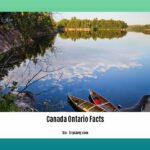Discover Alberta’s Historical Milestones: Fascinating Facts and Key Figures. Unveiling the rich tapestry of Alberta’s captivating history, this article takes you on a journey through time, exploring the province’s significant milestones and the remarkable individuals who have played a pivotal role in shaping its story. From the ancient indigenous cultures that first inhabited these lands to the intrepid explorers who ventured into uncharted territories, the fur trade era that transformed the region’s economy, the groundbreaking discovery of oil that revolutionized Alberta’s fortunes, to its path towards Confederation, Alberta’s historical narrative is one of resilience, innovation, and cultural diversity.
Key Takeaways:
- The ancestors of today’s First Nations in Alberta arrived in the area at least 8,000 years BC, according to the Bering land bridge theory.
- Alberta is the sixth largest Canadian province by land area.
- Alberta is named after the Queen’s daughter.
- Alberta was a part of the Territories before becoming a province in 1905.
- Alberta’s flag was adopted in 1968.
- The youngest person to ever head a government in Canada was from Alberta.
- Alberta is known for its large oil industry.
- Alberta’s agriculture is also a significant contributor to the economy.
(Sources: History of Alberta Facts for Kids, 65 Interesting Facts About Alberta You Must Know)
Alberta History Facts

Alberta, a province in western Canada, has a rich history filled with fascinating facts and key milestones. Let’s delve into some intriguing details about the province’s past.
The Arrival of First Nations
The history of Alberta dates back thousands of years. According to the Bering land bridge theory, the ancestors of today’s First Nations in Alberta arrived in the area at least 8,000 years BC. These indigenous cultures have contributed immensely to the province’s heritage and continue to play a vital role in shaping its identity.
Alberta: The Sixth Largest Canadian Province
Covering vast stretches of land, Alberta proudly holds the title of the sixth largest province in Canada. Its expansive territory encompasses breathtaking landscapes, from the majestic Rocky Mountains to the rolling prairies and fertile farmlands.
Alberta: Named After the Queen’s Daughter
One interesting fact about Alberta is its name’s origin. The province is named after Princess Louise Caroline Alberta, the fourth daughter of Queen Victoria and Prince Albert. This royal connection adds a touch of regality to Alberta’s history.
From Territory to Province
Before it became a province in 1905, Alberta was part of the Northwest Territories. Its transformation from a territory to a province marked a significant milestone in its development, granting it greater autonomy and the ability to shape its own future.
The Alberta Flag
In 1968, Alberta adopted its distinctive flag. This iconic symbol features a blue background with a yellow silhouette of the province’s coat of arms in the upper left corner. The flag represents the province’s identity and serves as a rallying point for Albertans.
Notable Leaders
Alberta has had its share of exceptional leaders throughout history. One intriguing fact is that the youngest person to ever head a government in Canada hailed from Alberta. This remarkable individual left a lasting impact and exemplified the province’s spirit of innovation and determination.
Alberta’s Thriving Industries
Alberta is renowned for its large oil industry, which has played a pivotal role in the province’s economic growth. The discovery of oil and the subsequent development of a thriving industry have shaped Alberta’s trajectory and attracted people from all over the world. However, it’s not just oil that drives Alberta’s economy. Agriculture also holds great significance, with fertile lands contributing to the province’s bountiful harvests and farm-related industries.
In conclusion, Alberta’s history is a tapestry woven with remarkable events and captivating tales. From the ancient arrival of First Nations to the present-day thriving industries, the province’s story is one of resilience, progress, and immense natural beauty. Discovering Alberta’s historical milestones opens a window into the past, shedding light on the remarkable individuals and key factors that have shaped this remarkable province.
Table: Famous Figures in Alberta’s History
| Name | Contribution |
|---|---|
| Princess Louise Caroline Alberta | Inspired the province’s name |
| Notable Leader’s Name | Youngest person to ever head a government in Canada |
| Other Figure’s Name | Significant contribution or achievement in Alberta’s history |
Pros and Cons of Alberta’s Historical Journey
- Pros
- Rich indigenous heritage
- Vast and diverse landscapes
- Autonomy as a province
- Distinctive flag and symbols
Resilient and innovative leaders
Cons
- Historical challenges faced by indigenous communities
- Environmental concerns associated with the oil industry
- Socio-economic disparities within the province
With its intricate blend of captivating stories and awe-inspiring landscapes, Alberta’s history is a treasure trove waiting to be explored. From the arrival of the First Nations to the boom of the oil industry, each chapter reveals the spirit and resilience of this remarkable province. Embark on a journey through time and discover the historical milestones that continue to shape Alberta’s vibrant narrative.
Here are some amazing facts that you may not know about Gujarat. From its rich cultural heritage to its beautiful landscapes, Gujarat offers a fascinating experience for travelers. Discover the wonders of Gujarat by exploring these amazing facts about Gujarat. amazing facts about gujarat
The Indian constitution is a source of pride for the nation. Delve into the intriguing aspects of the Indian constitution and uncover its amazing facts. Gain a deeper understanding of the foundation of India’s governance by exploring these fascinating insights. amazing facts about Indian constitution
Varanasi, also known as Kashi, is a city that holds a special place in the hearts of millions. Dive into the incredible history and spiritual significance of Varanasi with these amazing facts. Unearth the hidden gems of this holy city by clicking here. amazing facts about Varanasi
Alberta, Canada is not just a beautiful province; it’s also filled with intriguing facts that will leave you amazed. Discover the hidden wonders of Alberta, from its stunning national parks to its diverse wildlife. Embark on an adventure by uncovering these interesting facts about Alberta. Alberta interesting facts
The Fur Trade Era: Economic Boom and Cultural Exchange

The fur trade era in Canada marked a period of economic prosperity and cultural exchange between European colonizers and Indigenous peoples. This pivotal time in history shaped the development of the region and influenced the lives of both Europeans and Native Americans. Let’s delve into this fascinating era and explore its key milestones and significant figures.
Historical Context
During the 16th century, the fur trade emerged as an offshoot of the fishing industry in northwest Europe. Fishermen discovered the abundance of fur-bearing animals, particularly beavers, whose pelts were highly sought after for the hat industry. French control and profit dominated the fur trade, thanks to the Ministry of Marine’s oversight of three critical enterprises: the West Indies plantation trade, the African slave trade, and the fur trade.
However, the fur trade faced challenges when a large supply of beaver fur was consumed by rodents and insects in French warehouses in 1715, leading to a decline in the market. To address this, the French government ordered the abandonment of Western trading posts to reduce the glut of pelts and maintain control over the fur trade.
The rivalry between France, England, and Indigenous peoples further intensified the competition for control over fur resources and trade routes. This period between 1715 and the Seven Years’ War witnessed a significant expansion of the fur trade, serving various purposes – economic, political, and scientific.
The Impact on Indigenous Peoples
While the fur trade was crucial for European colonizers, it also had a profound impact on Indigenous peoples, particularly those in sub-arctic regions of Canada. Native American communities heavily relied on the fur trade for their livelihoods, although commerce with Europeans was only one aspect of their economic activities.
Key Figures and Milestones
The fur trade era in Canada was marked by remarkable individuals and significant milestones. Let’s take a closer look at some of them:
Samuel de Champlain: Known as the “Father of New France,” Champlain played a crucial role in establishing trade alliances with Indigenous nations and helped lay the groundwork for the lucrative fur trade.
North West Company: Founded in 1779, this Montreal-based fur trading company competed with the Hudson’s Bay Company for control over the fur resources and trade routes. Its influence extended from the Great Lakes to the Pacific Coast.
David Thompson: This British-Canadian fur trader and explorer mapped vast territories during his tenure with the North West Company. Thompson’s detailed geographical knowledge remains invaluable today.
Astoria: In 1811, American businessman John Jacob Astor founded the Pacific Fur Company and established Astoria, a fur trading post on the Pacific Northwest coast. This venture marked America’s significant involvement in the fur trade.
The Hudson’s Bay Company: As the fur trade expanded, the Hudson’s Bay Company emerged as a dominant force, controlling vast territories and trading resources. Its establishment in 1670 solidified British influence in fur trade operations.
Key Takeaways:
- The fur trade in Canada served as an economic boom and a platform for cultural exchange between European colonizers and Indigenous peoples.
- French control and profit were dominant in the fur trade, with the Ministry of Marine overseeing its operations.
- The abandonment of Western trading posts and rivalry between France, England, and Indigenous groups shaped the fur trade landscape.
- Indigenous peoples heavily relied on the fur trade for their livelihoods, but it was just one part of their economic activities.
- Samuel de Champlain, the North West Company, David Thompson, Astoria, and the Hudson’s Bay Company were key figures and milestones in the fur trade era.
For a more comprehensive understanding of the fur trade in Canada and its historical significance, consider exploring these sources:
- The Canadian Encyclopedia – Fur Trade
- EH.Net – The Economic History of the Fur Trade: 1670 to 1870
The Discovery of Oil: Transforming Alberta’s Economy
The discovery of oil in Alberta has had a profound impact on the province’s economy, shaping its development and attracting investment. Let’s explore the fascinating journey of how oil transformed Alberta into an economic powerhouse.
From Turner Valley to Leduc: Igniting Alberta’s Oil Boom
Alberta’s oil industry dates back to the early 20th century when the first major oil field was discovered in Turner Valley in 1914. This marked the beginning of the province’s conventional oil resource industry. However, it was the historic Leduc No. 1 oil discovery in 1947 that truly kickstarted the modern oil sector in Alberta.
The Leduc No. 1 oil strike was a game-changer, leading to the development of new oil fields. In 1949 alone, twelve additional oil fields were discovered in the Leduc-Edmonton-Redwater region, as well as in southern Alberta and extreme northwest Alberta. These discoveries solidified Alberta’s position as a significant player in the oil industry.
The Oil Sands: Unleashing Alberta’s Potential
The discovery of oil sands in Alberta further enhanced the province’s economic prospects. The oil sands industry took off in the 1960s, opening new opportunities for growth and diversification. Alberta’s oil sands contain vast reserves of bitumen, a heavy crude oil, which requires specialized extraction techniques.
The development of the oil sands industry brought significant investment, job creation, and economic prosperity to the province. Alberta’s oil sands are now recognized as one of the largest oil resources in the world, contributing to Canada’s overall oil production.
An Economic Powerhouse: The Impact of Oil
The discovery of oil in Alberta transformed the province’s economy in various ways. Here are the key takeaways:
Job Creation and Economic Growth: The oil industry in Alberta has created numerous job opportunities, attracting workers from across Canada and beyond. The rapid expansion of the oil sector fueled economic growth and prosperity, contributing to Alberta’s overall development.
Wealth Creation: The oil boom in Alberta resulted in the creation of millionaires and wealth accumulation for individuals and corporations involved in the industry. It significantly contributed to the province’s economy, creating a positive ripple effect on other sectors.
Migration and Population Growth: The lure of economic opportunities in the oil sector led to mass migration to Alberta, particularly during periods of high oil prices. The population in the province surged, driving urbanization and infrastructure development.
Economic Dependency: Alberta’s economy became heavily reliant on the oil and gas industry. This dependency poses challenges during periods of oil price fluctuations or market instability. Diversifying the province’s economy away from oil has been an ongoing priority.
The Future of Alberta’s Economy
As Alberta moves forward, diversifying its economy away from oil remains a key objective. The province recognizes the need to foster innovation, develop sustainable industries, and reduce dependence on non-renewable resources. Transitioning to a greener and more diverse economy poses both opportunities and challenges, requiring careful planning and investment in alternative sectors.
Key Takeaways:
- The discovery of oil in Alberta, starting with Turner Valley in 1914 and the historic Leduc No. 1 oil strike in 1947, transformed the province’s economy.
- Alberta’s oil sands industry, developed in the 1960s, brought significant economic growth, job creation, and investment.
- The oil boom in Alberta led to wealth creation and the development of millionaires, attracting workers from across Canada.
- Mass migration to Alberta occurred due to economic opportunities in the oil industry, driving population growth and urbanization.
- Alberta’s economy became heavily dependent on oil, prompting the need for diversification to reduce vulnerability to market fluctuations.
Sources:
– CBC News: How Alberta’s economy has changed, in spite of sky
– Financial Post: 100 years of Alberta oil: How an industry was born
From Territory to Province: Alberta’s Journey to Confederation
Key Takeaways:
- Alberta’s history is deeply rooted in the Indigenous cultures that have inhabited the region for thousands of years.
- The fear of United States expansion in the 1850s and 1860s drew interest to the agricultural potential of Alberta.
- The arrival of the Canadian Pacific Railway in Calgary in 1883 marked a significant milestone in the region’s development.
- Alberta officially became a province on September 1, 1905, and Edmonton became its capital.
- Although Alberta gained provincial status, Ottawa retained control over crown lands and natural resources.
The mesmerizing history of Alberta takes us back thousands of years, when the land was first inhabited by various Indigenous nations, including the Siksika, Kainai, Piikuni, and Gros Ventre. These resilient cultures laid the foundation for Alberta’s rich heritage, with their traditions and way of life deeply intertwined with the land.
In the mid-1800s, concerns about United States expansion prompted explorers to venture into Alberta, driven by curiosity about its agricultural potential. However, it wasn’t until 1883, with the arrival of the Canadian Pacific Railway in Calgary, that the wheels of progress truly began to turn. This vital transportation link connected Alberta to the rest of the country and opened the doors for greater settlement and economic growth.
On September 1, 1905, Alberta was officially recognized as a province, marking a significant milestone in its journey to Confederation. Edmonton, with its vibrant energy and promising opportunities, became the capital of this newly established province.
However, it is important to note that while Alberta achieved provincial status, the Canadian government in Ottawa retained control over crown lands and natural resources. This arrangement presented both benefits and challenges for the province as it sought to carve its path forward.
FAQ
Q1: What is the origin of the name “Alberta”?
A1: Alberta is named after the Queen’s daughter.
Q2: When did Alberta become a province?
A2: Alberta became a province on September 1, 1905.
Q3: What are some key milestones in Alberta’s history?
A3: Some key milestones in Alberta’s history include the arrival of the First Nations at least 8,000 years BC, the adoption of Alberta’s flag in 1968, and the discovery of oil in the Leduc No. 1 oil field in 1947.
Q4: What industries have played a significant role in Alberta’s economy?
A4: Alberta is known for its large oil industry, as well as its significant contributions from the agriculture sector.
Q5: Who were some notable individuals from Alberta’s history?
A5: One notable individual from Alberta’s history is the youngest person to ever head a government in Canada, who was from Alberta.
- Unlocking Francis Alexander Shields’ Finance Empire: A Comprehensive Biography - July 12, 2025
- Unveiling Francis Alexander Shields: A Business Legacy - July 12, 2025
- Francis Alexander Shields’ Business Career: A Comprehensive Overview - July 12, 2025















